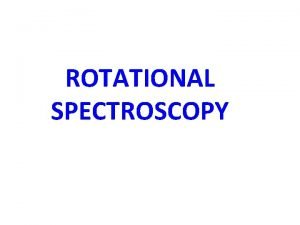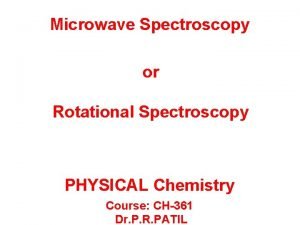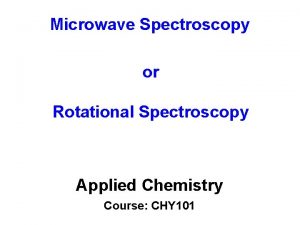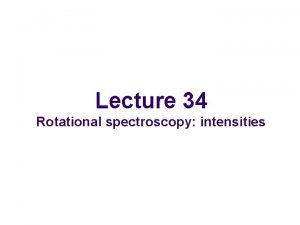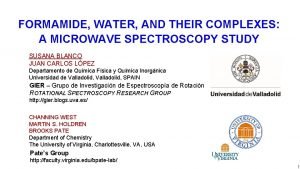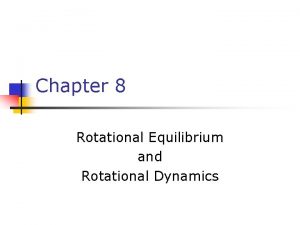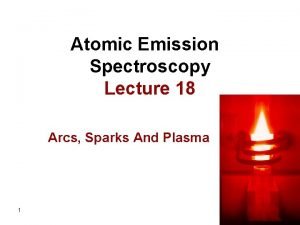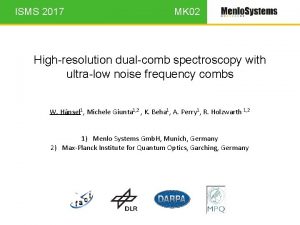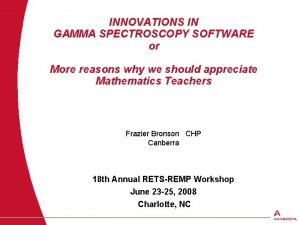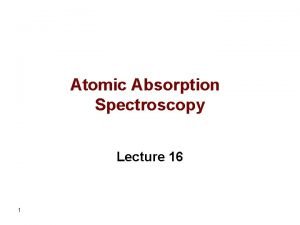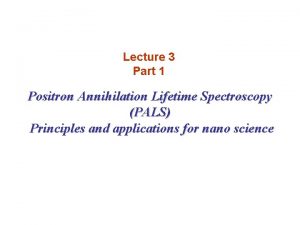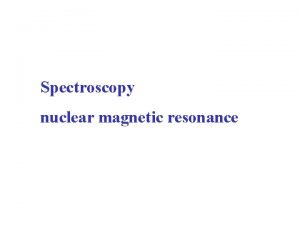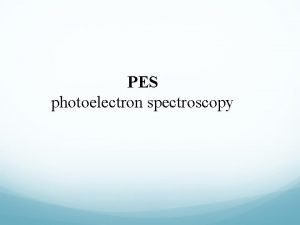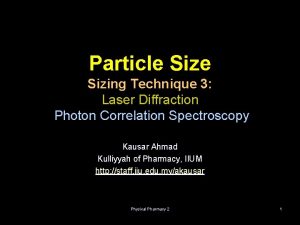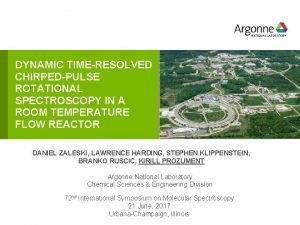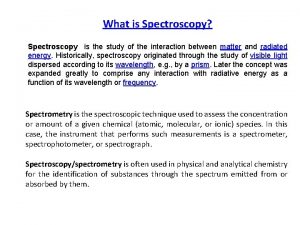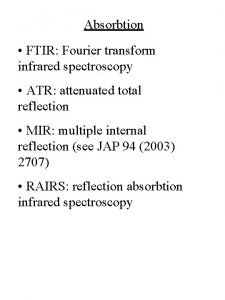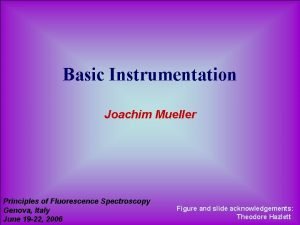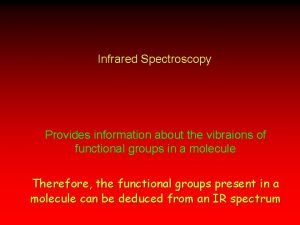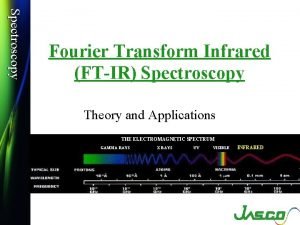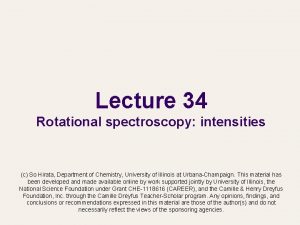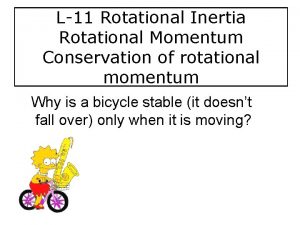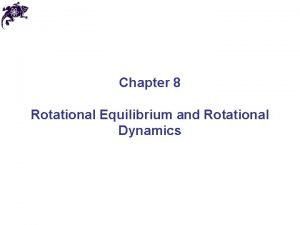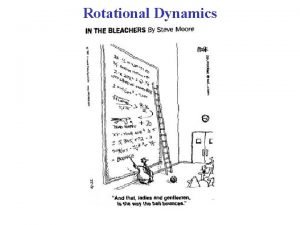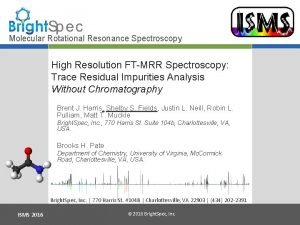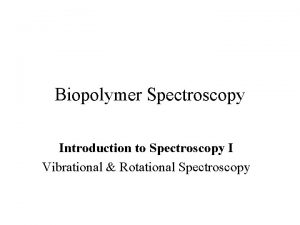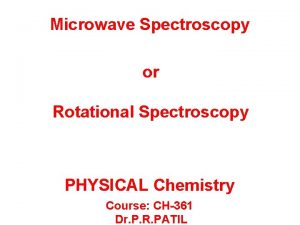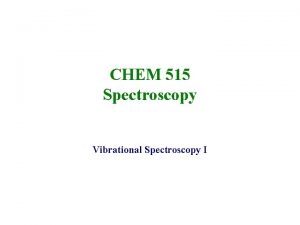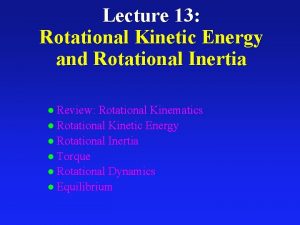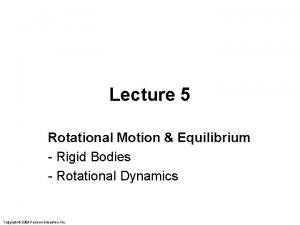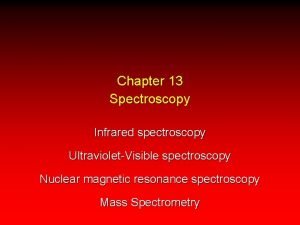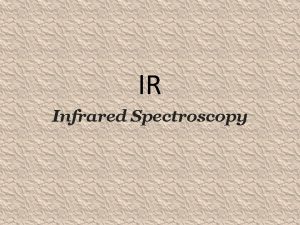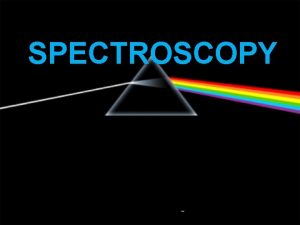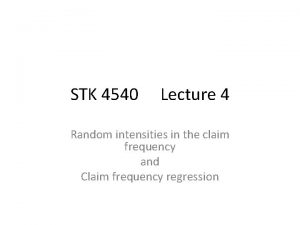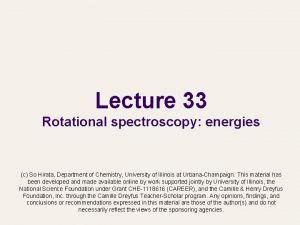Lecture 34 Rotational spectroscopy intensities Rotational spectroscopy l























- Slides: 23

Lecture 34 Rotational spectroscopy: intensities

Rotational spectroscopy l l In the previous lecture, we have considered the rotational energy levels. In this lecture, we will focus more on selection rules and intensities.

Selection rules and intensities (review) l Transition dipole moment l Intensity of transition

Rotational selection rules Transition moment Oscillating electric field (microwave) No electronic / vibrational transition x-dipole

Rotational selection rules l Gross selection rule: nonzero permanent dipole l Does H 2 O have microwave spectra? Yes Does N 2 have microwave spectra? No Does O 2 have microwave spectra? No l l l

Quantum in nature Microwave spectroscopy How could astrochemists know H 2 O exist in interstellar medium? Public image NASA

Selection rules of atomic spectra (review) l From the mathematical properties of spherical harmonics, this integral is zero unless

Rotational selection rules l Specific selection rule:

Spherical & linear rotors l In units of wave number (cm– 1):

Nonrigid rotor: Centrifugal distortion Diatomic molecule

Nonrigid rotor: Centrifugal distortion Diatomic molecule Vibrational frequency

Nonrigid rotor: Centrifugal distortion Nonrigid Rigid

Appearance of rotational spectra l Rapidly increasing and then decreasing intensities Transition moment 2 Degeneracy Boltzmann distribution (temperature effect)

Rotational Raman spectra l l Gross selection rule: polarizability changes by rotation x 2 + y 2 + z 2 ~ Y 0, 0 Specific selection rule: xy, etc. are essentially Y 0, 0, Y 2, ± 1, Y 2, ± 2 Linear rotors: ΔJ = 0, ± 2 Spherical rotors: inactive (rotation cannot change the polarizability)

Rotational Raman spectra l Anti-Stokes wing slightly less intense than Stokes wing – why? l Boltzmann distribution (temperature effect)

Rotational Raman spectra l Each wing’s envelope is explained by l l Degeneracy Boltzmann distribution (temperature effect)

H 2 rotational Raman spectra l Why does the intensity alternate?

H 2 rotational Raman spectra l Why does the intensity alternate? Answer: odd J levels are triply degenerate (triplets), whereas even J levels are singlets.

Nuclear spin statistics l l Electrons play no role here; we are concerned with the rotational motion of nuclei. The hydrogen’s nuclei (protons) are fermions and have α / β spins. The rotational wave function (including nuclear spin part) must be antisymmetric with respect to interchange of the two nuclei. The molecular rotation through 180° amounts to interchange.

Para and ortho H 2 Singlet (para-H 2) Sym. Antisym. Nuclear (proton) spins Triplet (ortho-H 2) Antisym. Sym. With respect to interchange (180°molecular rotation)

Spatial part of rotational wave function l By 180 degree rotation, the wave function changes sign as (– 1)J (cf. particle on a ring)

Para and ortho H 2 Singlet (para-H 2) Sym. Antisym. Triplet (ortho-H 2)

Summary l l We have learned the gross and specific selection rules of rotational absorption and Raman spectroscopies. We have explained the typical appearance of rotational spectra where the temperature effect and degeneracy of states are important. We have learned that nonrigid rotors exhibit the centrifugal distortion effects. We have seen the striking effect of the antisymmetry of proton wave functions in the appearance of H 2 rotational Raman spectra.
 Rotational spectral lines
Rotational spectral lines Microwave spectroscopy
Microwave spectroscopy Rotational motion
Rotational motion Gross selection rule for rotational spectroscopy
Gross selection rule for rotational spectroscopy Rotational spectroscopy notes
Rotational spectroscopy notes Torque right hand rule
Torque right hand rule Second condition of equilibrium
Second condition of equilibrium Atomic emission spectroscopy lecture notes
Atomic emission spectroscopy lecture notes 01:640:244 lecture notes - lecture 15: plat, idah, farad
01:640:244 lecture notes - lecture 15: plat, idah, farad Isms spectroscopy
Isms spectroscopy Gamma spectroscopy software
Gamma spectroscopy software Types of interference in atomic absorption spectroscopy
Types of interference in atomic absorption spectroscopy Dept nmr spectroscopy
Dept nmr spectroscopy Positron annihilation spectroscopy ppt
Positron annihilation spectroscopy ppt P-diethylbenzene nmr
P-diethylbenzene nmr How does pes work
How does pes work Laser diffraction spectroscopy
Laser diffraction spectroscopy Mossbauer spectroscopy
Mossbauer spectroscopy Spectroscopy
Spectroscopy What is spectroscopy?
What is spectroscopy? Absorbtion spectroscopy
Absorbtion spectroscopy Principle of fluorescence spectroscopy
Principle of fluorescence spectroscopy Ir spectroscopy provides information about
Ir spectroscopy provides information about Jacquinot advantage
Jacquinot advantage
